This section provides reference information about the
scoreboard-related options you can access from the Author tab. If
you want to view, edit, create, or delete:
x
Reference: Scorecard Perspectives
Perspectives
indicate high-level classification for types of objectives. A given
perspective is, literally, a container that holds objectives. You
can view perspectives for any scorecard both on scorecard views
and in the Strategy Map.
To view and work with perspectives,
click Scorecards and expand the tree structure
under Perspectives, then click a perspective.
The following image shows the Edit Perspective form.
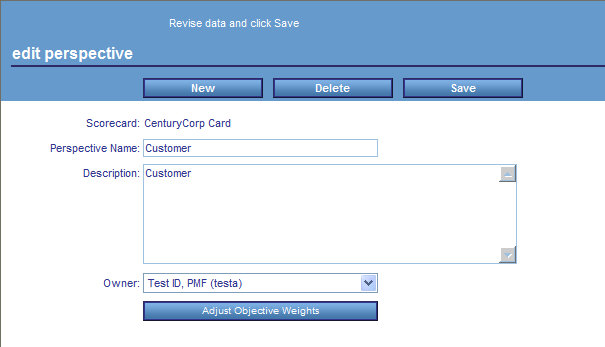
In the Edit Perspective
form, the same fields are required for adding a new or updating an
existing perspective. The following table lists and describes the
fields.
|
Field
|
Description
|
|---|
|
Scorecard
|
Name of the scorecard that contains this
perspective.
|
|
Perspective Name
|
Perspective name. The maximum number of
characters is 50.
|
|
Description
|
Text area to describe the intention of the
perspective. The maximum number of characters is 1024.
|
|
Owner
|
Select the owner from the list.
|
|
Adjust Objective Weights
|
Click this button to display a form in which
you adjust weighting percentages. For information on that form,
see Weighting Objectives Across a Strategy.
|
x
Reference: Scorecard Themes
Themes
usually relate to high-level corporate principles that drive overall
enterprise strategy.
To
view and work with themes, click Scorecards and
expand the tree structure under Themes, then
click a theme. The following image shows the Edit Theme form.
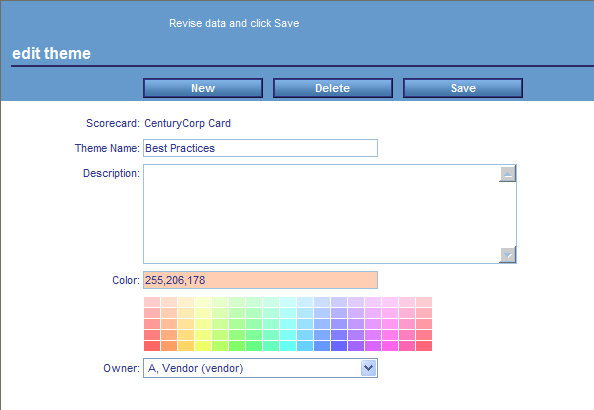
The same fields are
available whether you are creating a new, or editing an existing theme.
The following table lists and describes the fields in the Edit Theme
form.
|
Field
|
Description
|
|---|
|
Scorecard
|
Name of the scorecard that contains this
theme.
|
|
Theme Name
|
Name of the theme. The maximum number of
characters is 50.
|
|
Description
|
Text area to describe the intention of the
theme. The maximum number of characters is 1024.
|
|
Color
|
Color you select from the color palette.
|
|
Owner
|
Select the owner from the list.
|
x
Objectives
relate to high-level goals for business action. Objectives are usually
designed to be specific, measurable, action-oriented, results-driven, and
time-based (SMART).
You can view and work with objectives
in two ways:
- All objectives
for a given scorecard are displayable regardless of whether they have
been assigned to a perspective by clicking the Objectives panel
button in the Author tab. By expanding its tree structure, you will
see all the objectives in the scorecard and also any measures linked
to the objectives.
- Objectives
that have been linked to a perspective can be displayed by expanding the
perspective under the Scorecards panel button.
To edit,
delete, or create an objective, select the Objectives panel
button, expand an Objectives folder, click a desired objective,
and the Edit Objective form opens, as shown in the following image.
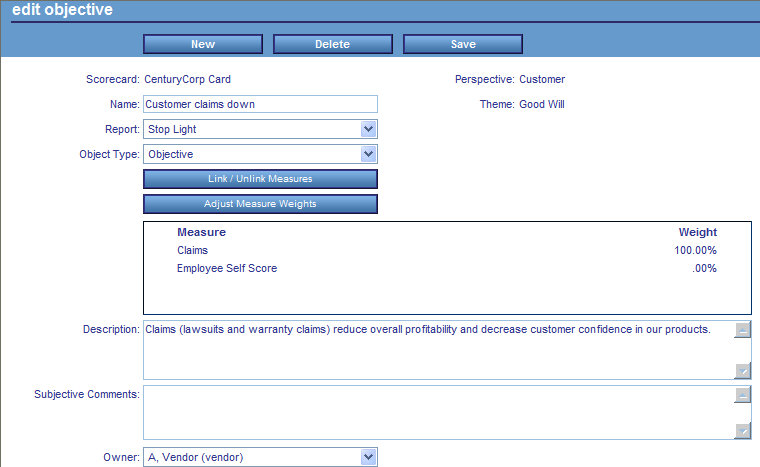
If you expand a specific
objective, one or more underlying measures are displayed. You can
select the measure to open the Edit Measure form where you can edit,
delete, or create a measure. For details on the Edit Measure form,
see Performance Management Framework Administrator.
The same fields
are required for adding a new or updating an existing objective.
The following table lists and describes the fields in the Edit Objective
form.
|
Field
|
Description
|
|---|
|
Scorecard
|
Name of the associated scorecard.
|
|
Perspective
|
Name of the perspective associated with
the objective in the scorecard tree, unless no perspective is associated
yet.
|
|
Name
|
Name of the objective. The maximum number
of characters is 50.
|
|
Theme
|
Name of the theme associated with the objective
in the scorecard tree, unless no theme is associated yet.
|
|
Report
|
View on which this objective appears.
|
|
Object Type
|
Shows whether the object is an Objective
or a Risk.
|
|
Description
|
Text area used for providing a brief description
of the objective. The maximum number of characters is 1024.
|
|
Subjective Comments
|
Text area used for adding a lengthy text
description. The maximum number of characters is 1024.
|
|
Owner
|
Defaults to the owner ID that is logged
on; or you can select another owner.
|
The following two buttons are also available
in the Edit Objective form:
x
A
risk describes an area that you are measuring that represents a
specific problem, or threat, to your enterprise. Risks can be placed
on the Strategy Map and you have the ability to link different metrics
to each risk.
All risks for a given scorecard are
displayable regardless of whether they have been assigned to a perspective
by clicking the Risks panel button in the Author
tab. By expanding its tree structure, you will see all the risks
in the scorecard and also any measures linked to the risks.
To
edit, delete, or create a risk, select the Risks panel
button, expand a Risks folder, click a desired risk, and the Edit
Risk form opens, as shown in the following image.
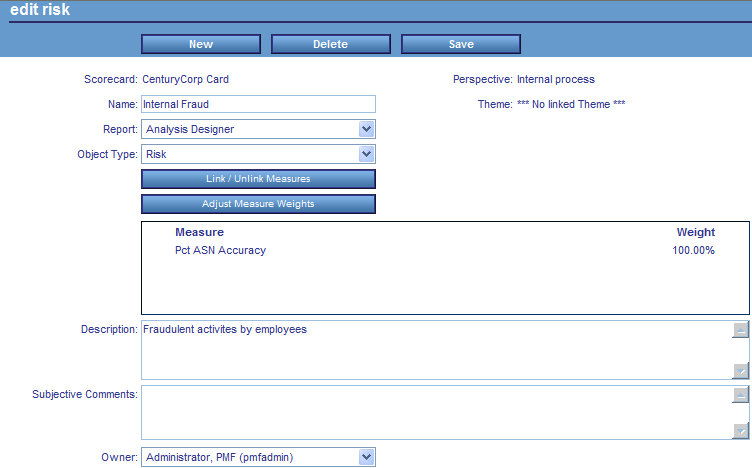
If you expand a specific
risk, one or more underlying measures are displayed. You can select
the measure to open the Edit Measure form where you can edit, delete,
or create a measure. For details on the Edit Measure form, see Performance Management Framework Administrator.
The same fields
are required for adding a new or updating a existing risk. The following table
lists and describes the fields in the Edit Risk form.
|
Field
|
Description
|
|---|
|
Scorecard
|
Name of the associated scorecard.
|
|
Perspective
|
Name of the perspective associated with
the risk in the scorecard tree, unless no perspective is associated
yet.
|
|
Name
|
Name of the risk. The maximum number of
characters is 50.
|
|
Theme
|
Name of the theme associated with the risk
in the scorecard tree, unless no theme is associated yet.
|
|
Report
|
View on which this risk appears.
|
|
Object Type
|
Shows whether the object is an Objective
or a Risk.
|
|
Description
|
Text area used for providing a brief description
of the risk. The maximum number of characters is 1024.
|
|
Subjective Comments
|
Text area used for adding a lengthy text
description. The maximum number of characters is 1024.
|
|
Owner
|
Defaults to the owner ID that is logged
on; or you can select another owner.
|
The following two buttons are also available
in the Edit Risk form:
x
Procedure: How to Link/Unlink Measures
To modify
the list of measures linked to an objective, perform the following
steps.
-
In the
Edit Objective or Edit Risk form, click the Link/Unlink
Measures button.
The Link Measures to Objective or Link Measures to Risk
form opens, as shown in the following image.
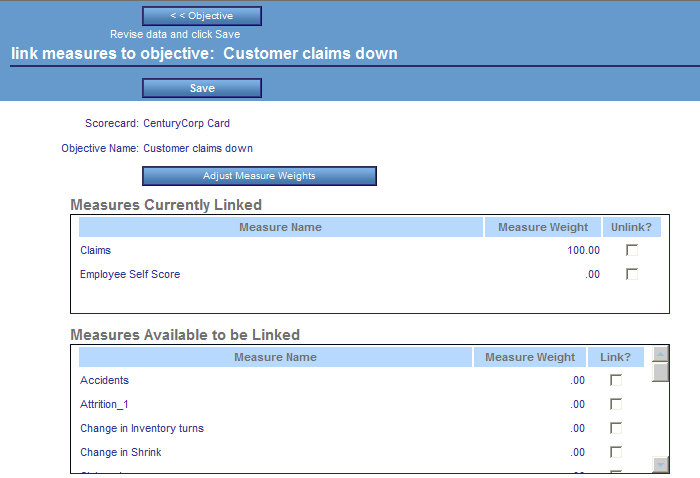
-
To link
a measure to the selected objective, find the desired measure in
the Measures Available to be Linked section of the form and select
the Link? check box.
You can link more than one measure by selecting all of
the applicable check boxes.
-
To unlink a measure associated with
the selected objective, find the measure under Measures Currently
Linked.
Select the Unlink? check box for the measure.
-
Click Save to
make the changes to the list of measures linked to the objective.
Your changes are reflected under Measures Currently Linked.
-
Click
the Adjust Measure Weights button to access
the Weight Measures Across Objective form to assign weighting percentages. For
instructions, see Weighting Measures Across Objectives.
It is strongly recommended that you adjust the weighting
of measures after changing linking relationships. If you do not
adjust weighting, metric totals may be inaccurate.
-
On the
Link/Unlink Measures form, click Objective or Risk to
display the Edit Objective or Edit Risk form again.
x
Projects
are similar to objectives since both have metrics assigned to them.
The major difference between a project and an objective is time. Objectives
are open-ended goals that are typically targeted and applied as
part of a strategy for its lifetime, while projects have well-defined
start and end times. You can measure the impact of projects on aligned
objectives and keep track of the progression of budgets and schedules.
In
PMF, you can add any number of projects from external project management
sources or by direct input, and track those projects. Projects can
be linked to operational views including a WebFOCUS view showing
project detail, a Web-based project or document, BPM systems, or
any other source. You have to set up an internal or external project
related source as a PMF launch page before you can establish an
Operational Report link to a PMF project.
To edit, create,
or delete a project, click the Projects panel button
in the Author tab, and select the desired project.
Alternatively,
you can access projects in an existing scorecard from the scorecard
tree. To do this, expand the desired Perspectives subfolder, expand
the desired Objectives folder, then expand the specific Objective
folder for which you want to add or edit a project. Click Projects,
and then click the specific project.
The following image
shows the Edit Project form.

For the fields that
prompt you for a date (for example, Projected End Date), click the calendar  icon to supply the information.
icon to supply the information.
The
system creates any new measures needed - one budget measure and
one schedule measure for each time period indicated in the start
and end date fields, and at the level indicated in the Time Level
Tracking drop-down list.
Users enter the Completed Date, which
causes the percent done measure target to be automatically generated
for each time period over which the project spans. Changes can add or
delete records, and adjust targets.
The same fields are required
for adding a new or updating an existing project.
The following table lists and describes
the fields in the Edit Project form.
|
Field
|
Description
|
|---|
|
Project Name
|
The name of the project. The maximum number
of characters is 50.
|
|
Description
|
Text area to describe the project. The maximum
number of characters is 1024.
|
|
Owner
|
Select the owner from the list.
|
|
Project Report
|
Select from the Project Report drop-down
list to establish a link that drills out to an internal (WebFOCUS)
or external (Web-based) Project, report, or other documentation
source.
To view the selected Project Report, select the name
of the project that you edited from any report in PMF and select Operational
Report from the pop-up menu.
|
|
Start Date
|
Start date for this project. Note: If
you move the start date forward in time for an existing project
and you cross a time period boundary, PMF deletes all existing measures
created prior to the new start date. If you move the start date
back in time and cross a time period boundary, PMF creates new measure entries
for time periods prior to the previous start date. In both situations
you can enter a revised total budget. Also, PMF will adjust the
percentage reached figures.
|
|
Original Planned End Date
|
Original estimated end date for this project
if the projected end date is changed.
|
|
Projected End Date
|
Estimated end date for this project. Note: If
you move the projected end date backward in time for an existing project
and you cross a time period boundary, PMF deletes all existing measures
created after the new end date. If you move the projected end date
forward in time and cross a time period boundary, PMF creates new
measure entries for time periods that fall after the previous projected
end date. In both situations you can enter a revised total budget.
Also, PMF will adjust the percentage reached figures.
|
|
Completion Date
|
Date/time of the completion of this project.
|
|
Time Level Tracking
|
Time period used to track the project. Select
from Year, Quarter, or Month. Note: If you change this setting
for an existing project, PMF deletes all existing measures for that project.
|
|
Total Budget
|
The total budgeted costs.
|
|
Total Schedule
|
The total budgeted schedule.
|
|
Budget Threshold
|
Percent value to be used for the threshold,
which determines when an indicator shows red for this project's
budget.
|
|
Budget Flex
|
Percent value to be used to determine the
inner edge of the yellow indicator zone for this project's budget.
|
|
Schedule Threshold
|
Percent value to be used for the threshold,
which determines when an indicator shows red for this project's
schedule.
|
|
Schedule Flex
|
Percent value to be used to determine the
inner edge of the yellow indicator zone for this project's schedule.
|
|
Measure Period
|
The current period of time for this project,
which is based on the time level tracking setting.
|
|
Target Budget
|
The target cost value of this project.
|
|
Actual Budget
|
The actual cost value of this project.
|
|
Target Schedule
|
The target scheduled time for this project.
|
|
Actual Schedule
|
The actual time used for this project.
|
x
Process
tracking enables you to align objectives to core business processes
and to link your processes to supporting documentation. You can
align any existing process to one or more objectives with the Strategy
Map. One measure series is defined and named for each process, and
can be input using the New Measure Wizard.
Processes can be linked to operational
views including a WebFOCUS view showing project detail, a Web-based
project or document, BPM systems, or any other source. You have
to set up an internal or external process related source as a PMF
launch page before you can establish an Operational Report link
to a PMF process.
To edit, create, or delete a process, click
the Processes panel button in the Author
tab, and select the desired process.
Alternatively, you can
access processes in an existing scorecard from the scorecard tree.
To do this, expand the desired Perspectives subfolder, expand the
desired Objectives folder, then expand the specific Objective folder
for which you want to add or edit a process. Click Processes,
and then click the specific project.
The following image
shows the Edit Process form.
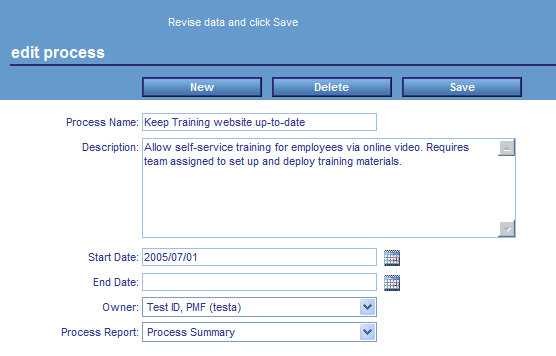
For the fields that
prompt you for a date (for example, Start Date), click the date
and time icon to supply the information.
The same fields
are required for adding a new or updating an existing process. The following
table lists and describes the fields in the Edit Process form.
|
Field
|
Description
|
|---|
|
Process Name
|
The name of the process. The maximum number
of characters is 50.
|
|
Description
|
Process description. The maximum number
of characters is 1024.
|
|
Start Date
|
Start date for this process.
|
|
End Date
|
End date for this process.
|
|
Owner
|
Select the owner from the list.
|
|
Process Report
|
Select from the Process Report drop-down
list to establish a link that drills out to an internal (WebFOCUS)
or external (Web-based) Project, report, or other documentation
source.
To view the selected Process Report, select the name
of the process that you edited from any report in PMF and select Operational
Report from the pop-up menu.
|






